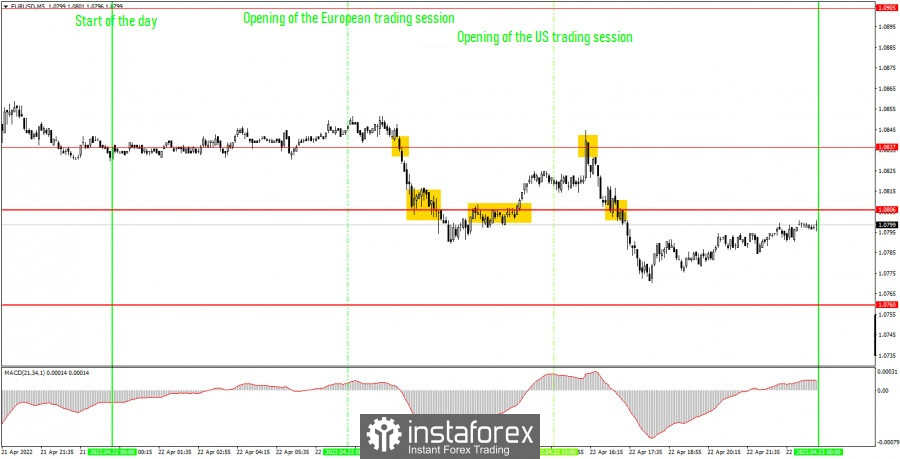Analysis of previous deals:
30M chart of the EUR/USD pair

The EUR/USD currency pair was in a downward trend again on Friday, but at the same time it could not move far down again. We have already said earlier that the downward trend for the euro/dollar pair persists, and this fact is beyond any doubt. Nevertheless, the pair continues to move downwards with the last of its strength. In other words, the bears are in no hurry to sell the euro, given that it is near its 15-month lows and not far from 5-year ones. However, the geopolitical, fundamental and macroeconomic backgrounds still aren't on the euro's side, so market participants simply have no choice but to sell. From time to time there are corrections that are based solely on technical grounds – the price cannot move constantly in only one direction. The volatility was quite good on Friday – about 80 points, but the price changed direction several times during the day, which only confused traders. There were quite a lot of macroeconomic reports, but not very important. The indices of business activity in the services and manufacturing sectors of the US and the EU did not provoke any market reaction. In fairness, it should be noted that their values were not too different from the forecasts and all were located above the key mark of 50.0. European Central Bank President Christine Lagarde's speech on Friday did not give any new information.
5M chart of the EUR/USD pair

The technical picture on the 5-minute timeframe doesn't look bad, but not too good either. The first sell signal was formed when the 1.0837 level was overcome. After that, the price went down about 40 points, surpassing the level of 1.0806 on the way. However, it could not move further down and returned to the area above the level of 1.0806. At this point, novice players had to close short positions. And also open long ones on a buy signal. After its formation, the pair returned to the level of 1.0837 and bounced off it, forming another pretty good sell signal. This time, after its formation, the pair went down about 55 points, but again failed to reach the level of 1.0760. But the buy signal was not formed either, so the last deal should have been closed manually in the late afternoon. As a result, three deals were opened on Friday and all three turned out to be profitable. The only downside is that the price turned around too much on Friday. It is good that this factor has been offset by accurate levels and signals.
How to trade on Monday:
The trend remains downward on the 30-minute timeframe, which is especially clearly seen on the higher TF. On the 30-minute TF, the movement was "smeared out" in time, so now you can't tell from the chart of this graph that the downward trend is still relevant. But it is relevant. And given that traders failed to overcome the level of 1.0923, we consider a further fall in the European currency to be the most likely scenario. On the 5-minute TF tomorrow, it is recommended to trade by levels 1.0727, 1.0760, 1.0806, 1.0837, 1.0905, 1.0923-1.0933. When passing 15 points in the right direction, you should set the Stop Loss to breakeven. No important publications or events scheduled for Monday in either the European Union or the United States. Thus, volatility may decrease, and the pair may trade sideways.
Basic rules of the trading system:
1) The signal strength is calculated by the time it took to form the signal (bounce or overcome the level). The less time it took, the stronger the signal.
2) If two or more deals were opened near a certain level based on false signals (which did not trigger Take Profit or the nearest target level), then all subsequent signals from this level should be ignored.
3) In a flat, any pair can form a lot of false signals or not form them at all. But in any case, at the first signs of a flat, it is better to stop trading.
4) Trade deals are opened in the time period between the beginning of the European session and until the middle of the American one, when all deals must be closed manually.
5) On the 30-minute TF, using signals from the MACD indicator, you can trade only if there is good volatility and a trend, which is confirmed by a trend line or a trend channel.
6) If two levels are located too close to each other (from 5 to 15 points), then they should be considered as an area of support or resistance.
On the chart:
Support and Resistance Levels are the Levels that serve as targets when buying or selling the pair. You can place Take Profit near these levels.
Red lines are the channels or trend lines that display the current trend and show in which direction it is better to trade now.
The MACD indicator (14,22,3) consists of a histogram and a signal line. When they cross, this is a signal to enter the market. It is recommended to use this indicator in combination with trend lines (channels and trend lines).
Important speeches and reports (always contained in the news calendar) can greatly influence the movement of a currency pair. Therefore, during their exit, it is recommended to trade as carefully as possible or exit the market in order to avoid a sharp price reversal against the previous movement.
Beginners on Forex should remember that not every single trade has to be profitable. The development of a clear strategy and money management are the key to success in trading over a long period of time.
 English
English 
 Русский
Русский Bahasa Indonesia
Bahasa Indonesia Bahasa Malay
Bahasa Malay ไทย
ไทย Español
Español Deutsch
Deutsch Български
Български Français
Français Tiếng Việt
Tiếng Việt 中文
中文 বাংলা
বাংলা हिन्दी
हिन्दी Čeština
Čeština Українська
Українська Română
Română

